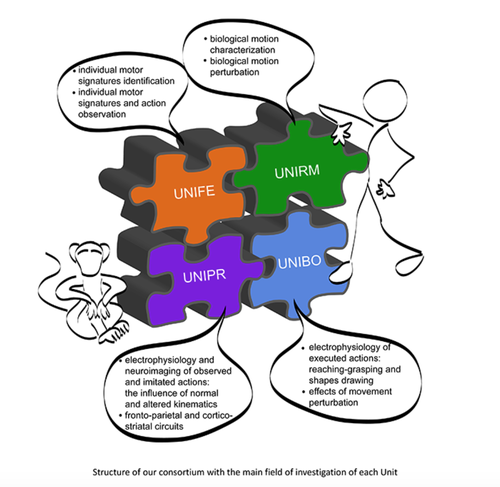- Home
- Research Interests Apri sottomenù
- Publications
- People
-
Projects
Apri sottomenù
- Progetto PNC - Fit4MedRob - Interfacce Neurorobotiche Ibride per il Controllo e il Recupero della Funzionalità Motoria e Verbale (NeuroRobCoRe)
- Progetto PNC - Fit4MedRob - Sistema innovativo per l'Analisi del Movimento e il Monitoraggio in Tempo Reale del Tremore (SMART-tremor)
- PRIN2022 - MulWalk
- Partenariato Esteso, funded by PNRR - Mnesys
- MSCA Staff Exchanges - PLACES
- PRIN 2020
- FETPROACT-2019 MAIA
- HumaneAINet
- Ricerca Finalizzata 2019 - GR-2019-12369242
- PRIN2017 - PACE
- H2020-MSCA-RISE-2016 - Platypus
- Agenda
PRIN 2020

The Neurophysiological Bases of Biological Motion: From Laboratory to Clinics
We are social animals. In fact, most of our life is spent interacting with other people for affective, leisure or work reasons. However, modern technology and its societal impact have transformed many direct interactions in virtual ones mediated by videos or avatar animations, requiring plausible rendering of biological movements along with the features idiosyncratic to each individual. Indeed, the current pandemic has revealed the critical importance of making virtual contacts as realistic as possible. Moreover, knowledge about biological movements is fundamental for effective human-machine (e.g., human-robot) interactions, which are responsible for increasing portions of workload.
What does it make biological a given movement? Which are the individual fingerprints ‘signing’ a given movement/action? How do we process and recognize people’s motion? How does the brain generalize individual movements and actions into categories? Are biological motions and individual motor signatures resistant to external perturbations? How do we react to the observation of actions close or far from our behavioral repertoire?
How do brain circuits responsible for the identification of own/others actions differentiate or integrate individual fingerprints? These are some of the questions we address here. Our ultimate goal is to tune-up new rehabilitation strategies, mainly for stroke patients, based on action execution/observation/imitation. The proposal is organized along the following Research Lines.
Line 1. Investigation of the generative mechanisms of the two-thirds power law linking movement speed and curvature, a ubiquitous law of biological movements. Identification of individual motor signatures during
movement execution and observation. Effects of whole-body vestibular and proprioceptive perturbations on the two-thirds power law and individual motor signatures. Role of the gravity reference in movement execution
and observation.
Line 2. Electrophysiological studies of the brain circuitry for motor tuning in macaques. Deciphering the role of different brain regions of parieto-frontal circuits in action execution, action reproduction, motor learning, and
motor perturbations. Injections of neuroanatomical tracers to define inter-regional connectivity.
Line 3. Neuroimaging and transcranial magnetic stimulation (TMS) studies in healthy humans. Brain circuits involved in decoding biological movement kinematics during action observation. Differential brain activations during passive observation versus observation with imitation. Test of the hypothesis that kinematics-based information is sufficient to produce motor learning. Differential activations of brain regions for observation of own-movements versus movements of others. Transient inactivation of parietal regions with TMS during reaching and grasping. Effects of whole-body vestibular and proprioceptive tilts in stroke patients. Personalized rehabilitation based on training with reinforcement learning.
Prof. Luciano Fadiga (Università di FERRARA)
Prof. Mirka Zago (Università degli Studi di ROMA "Tor Vergata" )
Prof. Patrizia Fattori (Università di BOLOGNA)
Prof. Leonardo Fogassi (Università degli Studi di PARMA)